But why go thru all the trouble of stem
cells if exosomes are the reason for the benefits? Which must be why no
one seems to be monitoring stem cell survival.
Application of stem cell-derived exosomes in ischemic diseases: opportunity and limitations
The latest here:
Does This 'Stem Cell' Therapy Contain Any Actual Stem Cells?
This transcript has been edited for clarity.
Welcome to Impact Factor, your weekly dose of commentary on a new medical study. I'm Dr F. Perry Wilson of the Yale School of Medicine.
Here's the pitch. You've heard of stem cells, right? They are these amazing cells that can change into any type of cell you may need, based on where you stick them. They can become blood vessels, brain cells, cartilage-producing cells. And here you are, with knee osteoarthritis that is just bone on bone. What I'm going to do is inject some stem cells into your knee, and they will take up residence there, make more cartilage, and heal your pain. Insurance won't cover this. I'll charge you, say, $5000.
That pitch has led to a $35 billion industry and a slew of stem-cell clinics popping up around the country making some really big promises.
But if you look at the data, the actual trials of stem cell therapy for conditions such as osteoarthritis, you will be very underwhelmed. Here's a study showing that the injections do no better than steroid injections, which are about 100 times cheaper and which, frankly, don't work that well in their own right.
In fact, you might conclude that these injections in the best case are, as my kids would say, pretty mid, and at the worst case just another variant of pseudoscientific nonsense. And this week, a new study has pushed me a bit more toward that pseudoscience interpretation.
I want to define my terms a bit here. The study I'm reporting on this week is not about using stem cells in the context of bone marrow transplant or something like that. This is really about those outpatient stem cell procedures, done in the office, to relieve various aches and pains.
Patients typically come to a "regenerative medicine" clinic and, after a consultation, have what amounts to a small bit of liposuction to harvest fat from the abdomen or, less commonly, a bone marrow aspirate. Both sources of tissue are thought to be rich in stem cells and are used interchangeably. The aspirated tissue is not processed — the FDA has not approved the use of cultured cells in these procedures — so basically the fat is sucked out of your belly and injected into your knee. That's the procedure.
So, right away you have to ask yourself: Did I get stem cells? Clearly, you got more than stem cells; you got fat cells and probably some blood and plasma, and various proteins and other substances.
Maybe the right question is, how many stem cells did I get? And that's where this study, appearing in Science Advances, takes off.
Researchers enrolled 21 participants and performed the same procedure happening at hundreds of clinics around the world. They aspirated some bone marrow and some abdominal fat, two supposedly interchangeable sources of stem cells. But instead of injecting them into knees, they injected them into some of the most sophisticated analytic machinery that a modern molecular biology lab has to offer.
Let me start with the first, biggest question: If you get an injection of fat from your belly into your knee, how much of that will consist of stem cells?
It turns out that there are some standard ways to define whether a given cell is a stem cell or not, based on markers that appear on the surface of the cell. The unique combination of the various markers tells us, in great detail, what kind of cell it is. One combination represents a T-helper cell; another is a fibrocyte. What we're looking for is mesenchymal stem cells, which have this particular surface marker combination.
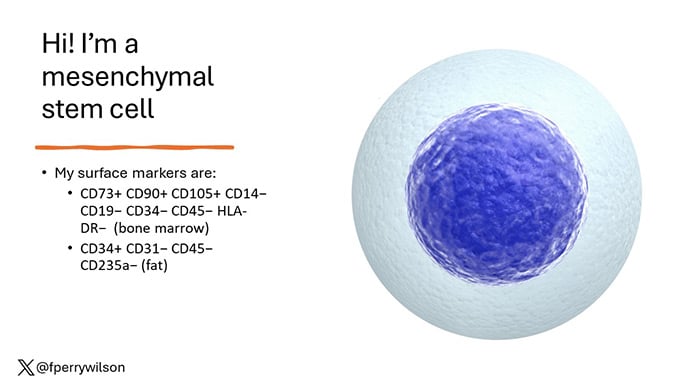
In sequential steps, filtering the data, the researchers probed the bone marrow slurry for these stem cells. And they found 3.5.
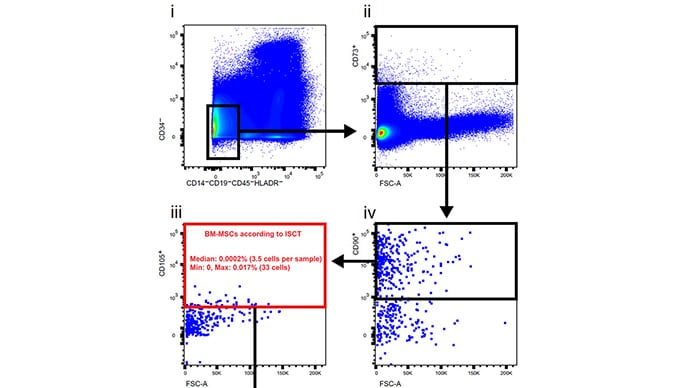
Not 3.5 million, not 3.5 thousand; 3.5 cells. Per sample.
One of the samples contained no stem cells at all. In the sample with the highest concentration, 0.017% of cells identified were stem cells. The number was so low that the researchers couldn't even rule out the possibility that all these cells were just false positives.
The fat sample did a bit better, with a median of 1.7% of identified cells appearing to be stem cells. But when those cells were examined, they found them to be of various different sizes and textures — not a uniform field of cells as they should be.
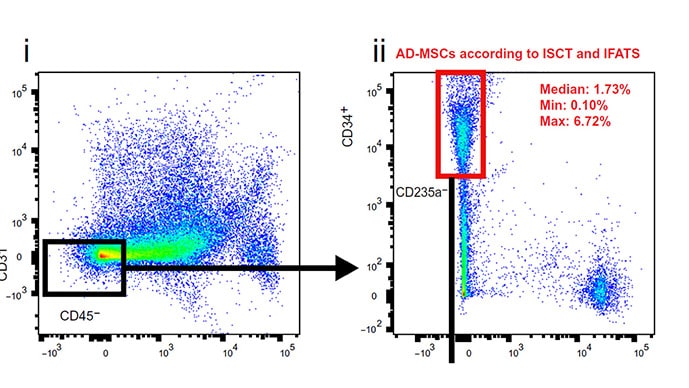
This also suggests a high false-positive rate. Maybe these preparations have basically no stem cells in them? Or maybe the definition of stem cell is wrong. The authors propose the latter and decide to try another way to find the elusive stem cells.
Enter tissue transcriptomics. Here, the RNA from the cells harvested from fat or bone marrow is analyzed. Instead of asking what the surface markers of the cells are, we are asking a more fundamental question: What are these cells doing? What are they making?
The answer, of course, is, a lot. But by measuring all that stuff, we can map how similar one cell is behaving to another in a plot like this. Each dot here is a cell; black dots are cells from bone marrow and pink dots come from fat.
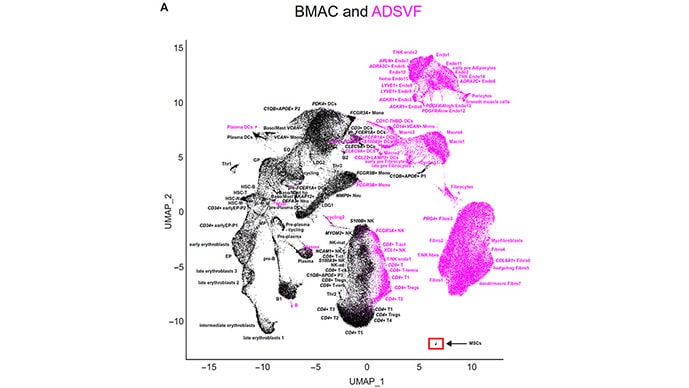
Note, first of all, that pink and black are not mixed together. That means that the cells from bone marrow and from fat are very different and not interchangeable, as suggested in the past.
And look at the bottom right, the little red box. Here are the only cells that appear to be stem cells — a tiny fraction (all black, by the way), so they are present only in bone marrow, not fat. But they are lost in a sea of other cells doing other things.
Another experiment enriched the slurry with cultured stem cells — the real deal, the gold standard — and no, you can't get them because cultured stem cells are not FDA-approved for injection for knee pain or anything else at this time. You can see there's a bunch of them, in blue, and that they are kind of close to the smattering of bone marrow stem cells but not overlapping.
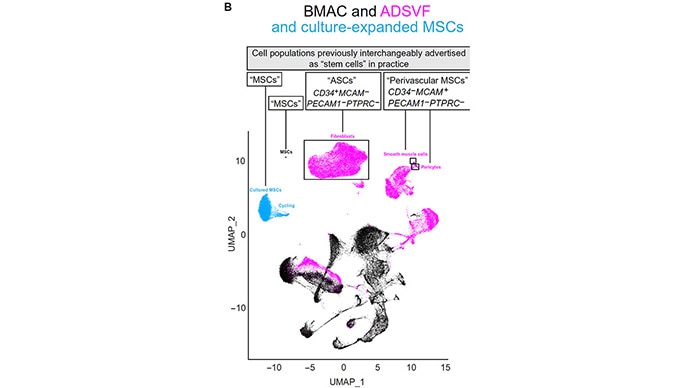
Looking at this, I would argue that if these injections work — a big "if" — then they do not work because of stem cells. There's a lot of other stuff in there.
So far we've only talked about cells. That's not all you get when you stick a needle into a fat pad and suck some out. You get a lot of protein as well. And the researchers characterized all the proteins in the fat and bone marrow aspirates.
Of note, only 10 of the proteins detected had some significant immunomodulatory function that might aid in healing a bad joint. And only four of the 10 were detected in both fat and bone marrow aspirates.
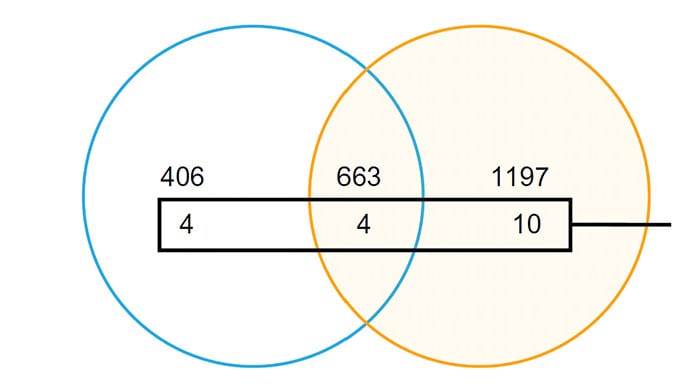
This is an incredibly detailed paper which comes with a fully interactive website too, so I encourage anyone interested to take a deeper look. But I think what I want to highlight here is that, basically, we have no idea how these "stem cell" injections work, if they work at all. And the reason for that is that when you inject a whole bunch of stuff into a joint — cells, proteins, fluids, cytokines, and so on — it becomes impossible to tell which substance is biologically active. Maybe the reason the trial data on these therapies are so all over the map is because the stuff you're injecting can be wildly different based on where you got it from.
It's not clear to me whether or how these injections work. What is clear to me is that the marketing of "stem cell therapy" and "regenerative medicine" absolutely works. It tells a great, simple story: harvesting your own body's cells to heal yourself. No medications, no surgery; just a bit of fat, a bit of hope, and $5000 that your insurance won't cover.
The idea, except the cost, is a nice one. But I think if we are being honest and really believe that stem cells are the magic bullet here, then we need to either isolate the stem cells prior to injection or, ideally, culture them to have enough of them to actually make a difference. Neither cell isolation nor culture for this purpose is FDA-approved now. To get approval, someone will need to show that their preparation actually works. If the marketing is right, that shouldn't be hard at all. Right?
F.
Perry Wilson, MD, MSCE, is an associate professor of medicine and
public health and director of Yale's Clinical and Translational Research
Accelerator. His science communication work can be found in the
Huffington Post, on NPR, and here on Medscape. He tweets @fperrywilsonand his book, How Medicine Works and When It Doesn't, is available now.
No comments:
Post a Comment